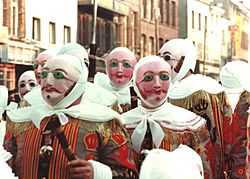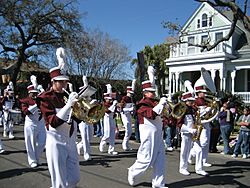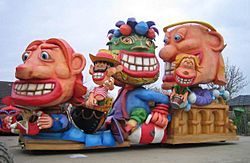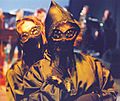Carnival facts for kids
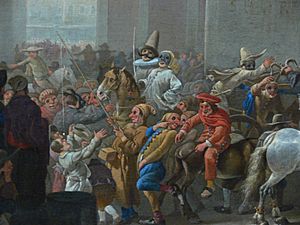
Carnival is a public festival which takes place in many cities and towns in many countries around the world. It is in February or March each year. Carnival can sometimes last for several weeks. In some places there is only one day of celebration. There are often street parades, bands, costumes and many people wear masks. Carnival is linked to religious traditions in the Catholic and Eastern Orthodox Churches, and it is also linked to local customs.
Contents
Background

Lent
Many Christian churches have a 40-day "season" of fasting called Lent, in which Christians prepare for Easter which is one of the two most important feasts in the Christian year (the other being Christmas). Easter is in late March or April. Lent always begins on a Wednesday, which is called Ash Wednesday in February or March. On that day, many people go to church and have some ash smeared on their forehead as a sign of sorrow for their sins. Then for 40 days, they try to work hard on improving themselves and thinking about the teachings of Jesus. It is usual for people to "give up" something for Lent. They might stop smoking or stop watching TV so they can spend more time reading the Bible or talking with the family. Many people give up all their favourite foods and have no cake, wine, beer, chocolate, ice cream or other luxury foods.
The name "carnivale" comes from Italian and means "putting aside the flesh". This means that during Lent people were not to think about their "flesh" (their bodies) but do things that were good for their souls. The word "flesh"" also means "meat" so many people would eat no meat during Lent.
Mardi Gras
Mardi Gras means "Fat Tuesday". This was the day just before Lent. The first day of Lent was called Mecredi Meagre meaning "Mean Wednesday". ("Mean" used to mean "poor" and "thin" rather than "nasty".)
During the Middle Ages in Europe, it was normal for people to have a big feast on the Tuesday before the Lenten fast started. In many towns this developed into a big public party, with entertainment in the town square. There is a famous painting by Pieter Bruegel dating from the 1550s and showing the "Battle of Carnival and Lent". (See top of page)
About Pieter Bruegel's famous painting

In this picture by Pieter Bruegel, a man representing Carnival is pushed on a barrel by people in costumes and masks. He is about to do battle with Lent. His weapon is a skewer covered with pieces of roast meat. He balances a blackbird pie on his head. Lent, who is very skinny, fights him with two little fish on a bread-board. The person at the front wears a mask and plays a very noisy instrument called a rummelpott.
Modern celebrations of Carnival
Nowadays many cities and towns around the world celebrate Carnival for a week or more. The final day of the celebration is Mardi Gras, when there is often a parade. In some cities the Mardi Gras parade is held on the weekend before Lent begins, rather than on the Tuesday, so as not to disturb the business and traffic of the town.
In some towns such as the Belgian town of Binche the preparations for the Carnival are complex and start many weeks before Carnival takes place, with most of the town's people taking part in some way. The Carnival of Binche is listed with UNESCO as an event of great historic importance because it has been held there in almost the same way for more than 500 years.
Carnival is celebrated differently around the world, but there are some things that are similar:
- There is often dressing-up in fancy costumes, which often include masks.
- There is usually a street parade of people and musicians. There may also be floats which are decorated vehicles.
- There is often loud noises, bright colours and scary faces. These are to frighten evil spirits away while people are fasting. A traditional reason that the performers wear masks is so that the evil spirits do not know who they are.
In the Carnival of Rio de Janeiro, which is one of the biggest and most famous in the world, a major feature is the glamorous costumes as both men and women wear bright colours and wonderful headdresses to dance down the street to the sound of many bands. In Rio there are many very large and expensive decorated floats.
The Barranquilla's Carnival, one of the biggest carnivals in the world, was declared the Masterpiece of the Oral and Intangible Heritage of Humanity by UNESCO.
In New Orleans the bands are one of the most important parts of the Carnival celebrations. In Düsseldorf in Germany, one of the features of the Carnival parades are the enormous models of politicians and other well-known people. In Sydney, the Sydney Gay and Lesbian Mardis Gras which started out as a parade for Sydney's homosexual community, now includes exhibitions, live theatre and competitions, and stretches over two weeks.
In Venice the Carnival was celebrated from December 26 until Lent began. During that time, people were allowed to disguise themselves by wearing masks in the street. In the 1930s this was forbidden by the Italian Government, but in 1980 a mask-makers shop was set up in Venice again. Soon the old tradition was brought back, and now many people dress in costume and wear masks for two weeks before Lent begins.
In Brussels in Belgium, the main Carnival procession is held in the Grande Place, the town square in front of the Gothic Town Hall with its huge tower. Every part of the procession is ruled by a tradition, but some of the traditions are so old that no-one remembers what they mean anymore. At the beginning of the procession is a large group of people dressed in beautiful costumes of silk and velvet, who act out an historic scene of the coming of the King of Spain and his royal court to Brussels 500 years ago. When they have taken their seats, there comes an amazing procession which includes stilt walkers, fire eaters, Goldilocks with a dancing bear, a mad camel, a wizard, lots of men in huge feathery headdresses, and the Archangel Michael whose job is to frighten the Devil. These characters are traditional to Brussels. In every city, the characters that take part are different.
Different uses of the word "carnival"
Although the word "carnival" still has its old meaning, it is often used to mean public entertainments of different kinds. Some towns have carnivals that have nothing to do with Lent and are at different times of year. Nowadays there are all sorts of different carnivals. Some of these carnivals, like the Notting Hill Carnival in London and the Melbourne Cup Racing Carnival in Australia are very famous.
The word "carnival" is now used for festivals, parades and competitions of all sorts. There are school sports carnivals, folk carnivals, multi-cultural carnivals, horse-racing carnivals, wine and food carnivals and boating carnivals.
Related pages
- Christianity
- Advent
- Christmas
- Epiphany (holiday)
- Ash Wednesday
- Lent
- Easter
- Pentecost
- Carnival of Blacks and Whites
Images for kids
-
Rio's carnival is the largest in the world according to Guinness World Records.
-
The traditional carnival of Acireale, Sicily
-
Carnival on Ice at the Kipdorppoort Moats in Antwerp, c. 1620
-
Carnival in Venice, by Giovanni Domenico Tiepolo, 1750
-
Riderless Racers at Rome by Théodore Géricault. From the mid-15th century until 1882, spring carnival in Rome closed with a horse race. Fifteen to 20 riderless horses, originally imported from the Barbary Coast of North Africa, ran the length of the Via del Corso, a long, straight city street, in about 21⁄2 minutes.
-
Recife Carnival, in the capital city of the State of Pernambuco, Recife
-
Carnival circuit of the city of Salvador
-
Carnival in Rincon (Bonaire) (2018)
-
The Blacks and Whites' Carnival in Pasto
-
Traditional cojuelo mask of the Dominican carnival in La Vega, Dominican Republic.
-
Carnival parade in Latacunga city.
-
Morenada dance, in the Carnival of Juliaca – Peru
-
Masqueraders chipping on Carnival Tuesday in Port of Spain during Trinidad and Tobago Carnival
-
Main square in Rijeka during Carnival
-
"Coprnice" (Witches) from Međimurje County, Northern Croatia
-
Reitenderle, der Grundholde, Hudelmale, Schnarragagges; popular Fasnet characters from Kisslegg im Allgäu, Swabia
-
From the Monstercorso on Güdisdienstag's evening in Lucerne (2009)
-
The float of the King Carnival parading in Patras, Greece
-
Ladies on their way to the historic Bourboulia ball in Patras, Greece wearing the dómino costumes unique to that ball.
-
The Battle of the Oranges at the carnival of Ivrea
-
Carnival procession in Valletta on Malta
-
A dancer in the Carnival of Madeira, on the island's capital Funchal
-
Boris Kustodiev's painting of Maslenitsa
-
The Burial of the Sardine, Francisco Goya, c. 1812
-
A choir singing in the Carnival of Cádiz
-
Vidalot is the last night of revelry before Ash Wednesday in Vilanova. Water color painting by Brad Erickson.
See also
 In Spanish: Carnaval para niños
In Spanish: Carnaval para niños


